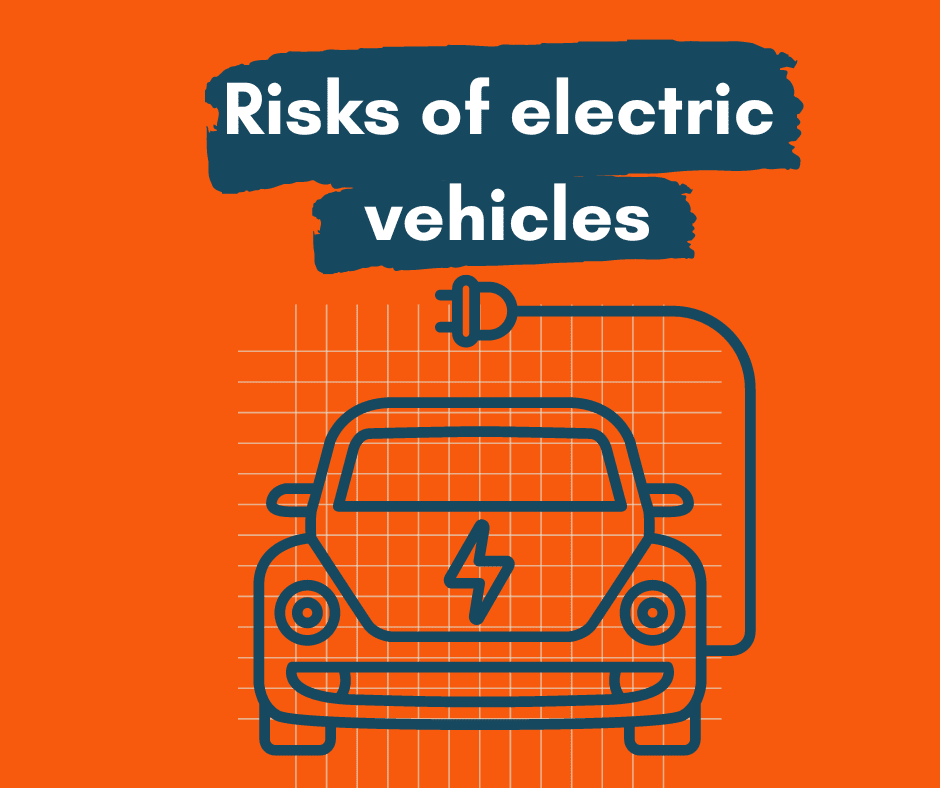Electric Vehicles – are you thinking of making the switch?

This blog is developed from NIG Risk Assist to inform you of the risks of electric vehicles to your business. Use this blog to inform and educate electric vehicle users in your organisation and carry out risk assessments.
__________
Electric Vehicles – identifying the possible risks for your business and how to deal with them.
Electric vehicles (EVs) are growing in popularity every day offering benefits over conventional, petroleum-fuelled vehicles, such as energy efficiency, reduced carbon emissions and fuel costs and improving an organisation’s overall environmental, social and corporate governance (ESG) credentials.
With their cost declining, their driving range increasing and new models coming on to market, as a fleet, transport or plant manager, you may be thinking of switching to EVs. This may include installing charging stations on site – either externally for motor vehicles and/or internally for e-bikes and electric scooters.
Before taking that step, you will need to take these factors into consideration when deciding what the best choice is for your organisation.
Associated Risks
Although fundamentally very safe there are risk factors associated with EVs that you will need to consider when completing your organisational risk assessments. These include:
Electric Vehicle Fires: There are concerns about the dangers and spontaneity of EV fires – the main danger occurring when the Lithium-ion battery is damaged. Fires associated with these batteries are not only intense, but they can also generate toxic fumes and hazardous chemicals even after the fire has been extinguished.
Charging stations can themselves pose an ignition risk. To reduce the risk, they should be kept in good repair and the surrounding area kept clear of debris.
You will find further guidance on the fire risks associated with electric vehicles, and how to manage them, in Electric Vehicle Fire Safety.
On-site safety: EVs are completely silent when moving around the workplace and car parks, giving no pre-warning to pedestrians in their vicinity. So, whether or not you have charging facilities on site, or include EVs in your company carpool or fleet, if they are likely to be on your premises or using your car parks, you must ensure that people are aware.
Charging e-bikes and Electric Scooters: Charging these vehicles indoors rather than in the open has two main advantages in that they can help prevent theft and avoid wet weather, which can make charging hazardous.
If you are thinking of offering facilities for charging e-bikes and electric scooters (in or outdoors) you should first discuss with your insurers to ascertain whether this will alter your insurance cover in any way.
For further guidance see e-bikes and Electric Scooters
Driver Training
If changing over to EVs, your drivers may require additional training and monitoring to ensure they are familiar with the differences to conventional vehicles, particularly with regards to vehicle handling and acceleration. Due to their fuel supply the power of EVs is available from a standing-start. This can expose inexperienced drivers to dangers.
See the Driver Training section in Electric (and Hybrid) Vehicles for further guidance.
Charging Points
There are 2 types of chargers to use for “re-fuelling” your EV.
Fast / rapid chargers are typically found in public car parks, petrol stations and shopping centres, allowing top up of the battery, from near flat to near full, in around 30 minutes. Slow chargers, trickle the charge through to the vehicle over several hours and are used at home, in the workplace, or from an increasing number of on-street sources.
Whist the UK currently has one of the world’s highest ratios of public charging points to battery cars (with over 50,000 public chargers) the rollout does not seem to be keeping pace with the increase of EVs coming onto our roads.
On-street charging at the kerbside, for use by those without a driveway or garage, is still much in its infancy. Charging stations at your workplace will be particularly important for your grey fleet / pool cars or company vehicles.
Regardless of how heavily you invest in on-site charging points, a sufficient range of public charging stations i.e. rapid charging, such as on motorways and in remote areas, will be essential in supporting your drivers undertaking long business journeys. Until access to public fast-chargers increases, recharging the vehicle mid-journey will require careful planning.
Things to factor in when planning journeys in EVs
Do you have enough “fuel” to complete your journey (and to get back) considering delays / diversions?
Are the chargers, at planned charging station stops, compatible with your vehicle?
Is an appropriate App required to use the charging station?
Using charging stations:
– Can you safely leave your vehicle while charging (do charging points have coded release)?
– Is there a place nearby where you can have a comfort break / get refreshments while leaving your vehicle on charge?
– Have you parked correctly ensuring the charging point is nearest to your port – so cables do not get in way of other users?
– Have you returned cables to their correct position so not on the ground where they could be a trip hazard?
Making the Change
The UK has committed to reducing greenhouse gas emissions by 28% by 2035 and moving to Net Zero by 2050. Transport, in particular cars, is the largest source of emissions (accounting for 27%). Transitioning from petrol and diesel cars to electric vehicles (EVs) is therefore key to helping organisations reduce their carbon emissions and contribute to meeting Net Zero.
With more public fast chargers installed providing quicker safer charging throughout the country and the increased driving range of the latest models, there are even more reasons to change from conventional to electric vehicles.
Useful Resources:
Electric and Hybrid Vehicle – maintenance & repair
EDF’s UK map of electric car charging points
For the Government’s official Residential approved charge-point model list
CMA Report on building a comprehensive/competitive EV charging sector that works for all drivers.
________
Talbot Jones Ltd is a family-run Chartered Insurance Broker specialising in Third Sector and Professional risks. Get in touch for free insurance advice, review or quotation.
Talbot Jones Ltd incorporates March Insurance Services, a Chartered Insurance Broker specialising in Agricultural and Hospitality Risks.





